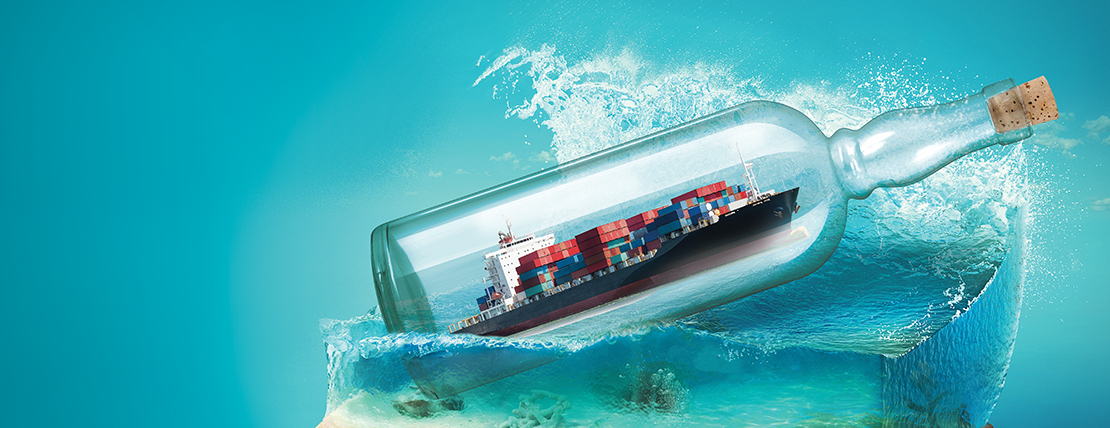Christine Cabau Woehrel puts it in pretty stark terms. “Without seafarers, there is no world trade,” said Woehrel, the executive vice president for industrial assets and operations at cargo carrier CAM CGM.
The maritime industry indeed plays a vital role in the world economy. The jobs and livelihoods of billions of people in the developing world, and standards of living in the industrialized and developed world, depend on ships and shipping. A full 90% of the world’s goods are transported by water and, before this past year, cruises were among the fastest-growing sectors of the global travel industry.
Moreover, the global ferry industry is roughly the same size as the commercial airline industry, transporting approximately 2.1 billion passengers per year. The global pandemic has put all segments of the maritime industry under tremendous strain, forcing shipping ports to close and affecting supply chains around the world. And it has devastated the cruise sector, with high infection rates among crew and passengers resulting in widespread disruption and cancellations.
While maritime organizations grapple with many of the same HR issues that all organizations face — recruitment and retention, onboarding and training, motivation and engagement, workplace well-being — their workforces, particularly their offshore crews, face very distinct challenges.
Life aboard any sea borne vessel is hazardous and demanding. Crew members typically work in months-on, months-off rotations to guard against burnout, which takes them away from their families for long stretches of time; and they need to be culturally aware because of the multinational nature of the workforce. Additionally, there are overarching management challenges stemming from the need to coordinate onshore/offshore staff and processes.
The pandemic heightened all of these challenges, particularly as many seafarers were deemed “essential workers,” forcing them to extend their rotations and risk exposure to the virus (they are particularly vulnerable as they work and live in close quarters). While parts of the world are beginning to put the pandemic in the rearview, it continues to rage in others. The specter is likely to remain for some time, which elevates the need for strict health and safety protocols, and increased attention to all facets of organizational well-being.
Keeping maritime businesses afloat, financially and literally, will depend on their ability to efficiently and effectively screen, manage and support large, diverse, multicultural and highly fluid populations. “Turning a large ship” is a time-honored metaphor suggesting the difficulties of changing a large organization. It also happens to be an especially on-the-nose metaphor for maritime organizations that have been particularly hard-hit by the global pandemic. They will need to rethink their HR, health and safety systems, processes and policies if they are to successfully relaunch their operations around the globe and become what many maritime organizations are not: agile and resilient.
Business Continuity
Business continuity in this post-pandemic world is based on safety, organizational well-being and the ability to recruit and retain talent, all of which will require unprecedented levels of flexibility, transparency and traceability. A 2019 survey by consulting firm Marsh found that maritime companies were not adequately prepared for automation on land and at sea; as is the case with organizations in all sectors, the pandemic has forced them to accelerate their digital evolution.
Safety First
The first step toward getting organizations back to a new normal is to efficiently manage every aspect of medical operations across their entire fleet of vessels, extending to all crew members and medical providers. Before the pandemic, all vessels had systems for reporting, trending and analyzing incidents pertaining to health and safety, communicating protocols and documenting that they are being followed.
The pandemic has made it imperative that they include communicable disease management and reporting that facilitates contact tracing, temperature and health screenings, compliance reporting and decision support, as well as quarantine, isolation and notification management.
The pandemic has made it imperative that organizations prepare for future pandemics and have in place systems and protocols for incident management and response.
One of the challenges for some maritime organizations is the disconnect between HR and health/safety systems; integrating and consolidating these systems (for instance, using a single database for crew records), allows the organization to access 360-degree views of each employee and quickly ascertain their employment and health status, while enabling them to mitigate the risks involved in overseeing onboard medical operations.
Safeguarding health and safety as a matter of course will also prepare organizations to respond to the next pandemic; the following outlines operational initiatives and tools that will enable them to remain on “safety first” footing:
- Centralize and manage all crew and guest case information. Whether it’s for a referral, emergency, repatriation or legal case, this will provide direct access to real-time information.
- Automate and enhance the management of public health and compliance required by various regulatory agencies such as the CDC Vessel Sanitation Program, Health Canada, European CDC and others.
- Ensure compliance with the various privacy regulations such as the U.S. Health Insurance Portability & Accountability Act (HIPAA) and the EU European Data Protection Regulation (GDPR).
- Have the ability to conduct virtual cabin consults and collaborate real-time with medical specialists while utilizing minimal bandwidth.
- It’s imperative to have tools that document and analyze individual or group events at the ship and fleet levels that indicate corrective action and enforce protocols to prevent such incidents in the future.
Productivity: Well-being and Mental Health
The International Transport Workers Federation conducted a recent crew change survey that found 60% of seafarers saying it was “more likely than not” that they or crewmates would be “involved in an accident that could harm human life, property or the marine environment due to fatigue while aboard.” Extended time on vessels is worsening fatigue, Allianz indicated in its 2020 Shipping & Safety report, adding that “human error is a contributing factor in 75% to 96% of marine incidents.”
In addition to causing fatigue and exposing crews to safety risk, extended rotations have meant that seafarers are away from families and familiar surroundings, exacerbating tensions and, according to experts and advocates, have created a mental health crisis.
“Most of us like to have some semblance or illusion of control for our lives and livelihood,” said the Rev. Mark Nestlehutt, president and executive director of the Seamen’s Church Institute, the largest welfare organization serving mariners and seafarers in North America.
“One of the things that weighs on seafarers stuck at sea is the lack of control. It can be hard to cope when you have no sense of when things are going to be normal,” Nestlehutt told the Washington Post.
Marissa Baker, an assistant professor at the University of Washington, is conducting a confidential survey that asks mariners a variety of questions about COVID-19, mental health, and their experiences and feelings when aboard a vessel during the challenges of this worldwide pandemic. Baker said mariners face many unique challenges.
“The COVID-19 pandemic is a very stressful time, and there are many aspects of being on a vessel that can make it even more stressful — such as being isolated from friends and family and not having consistent internet or phone access,” Baker told Workboat. “Changing schedules related to the pandemic, such as having to stay on a vessel longer than intended, can also cause increased stress and anxiety for mariners.”
Developing and implementing programs for the well-being of seafarers spending an excessive amount of time on board the vessels is paramount; as important is having a system to enroll, track and measure each crew member’s compliance with the programs and the ability to self-report progress.
In conjunction with a self-guided well- ness program, it’s also critical to provide measures and systems to mitigate the stressors of life off-hours. For instance, the crew eagerly anticipate port days, when they can leave the vessel and spend time onshore at the given port of call. Enabling them to plan activities and itineraries through a self-service portal in the lead-up to port day can be a great stress relief.
Additionally, providing HR and onboard officers with the ability to perform validation checks to ensure employees are being scheduled to sign on and off from the proper and/or preferred port days, assures an orderly and largely stress- free process on port day, which can be very hectic with lots of movement and attendant anxiety.
Given the longer rotations, making it easy for crew members to book flights home from a travel portal may seem like a trivial thing, but it can also go a long way in alleviating stress, knowing that their flight is secured and at a fixed point they will be returning home to see family and friends.
Recruiting and Retention
Before the pandemic, the industry had been grappling with staffing shortages even while seeing unprecedented demand for its services. There are a number of reasons the talent pool has diminished: The hardships of onboard work and life has prompted more seafarers than ever before to take shore-based maritime jobs, losing talent to other industries as many skills in the digital age are easily transferred from one industry to another; and the lack of promotion of seafaring as a career at a high school or college level, particularly among young women. As maritime organizations prepare to relaunch as the global pandemic recedes, they will need to accelerate, intensify and, in many areas, rethink their recruitment outreach.
The first order of business is implementing systems and protocols to promote safer and healthier onboard experi- ences, while relieving the stressors of onboard work and life. The HR organization will also need to find better ways of finding and engaging talent to meet the demand for skilled workers and competent leaders in all areas of marine activity. The maritime industry is in the early stages of automation; this will need to extend to HR if maritime companies are to have the ability to compete, particularly as their talent pool is global.
Efficient talent acquisition for any maritime organization is difficult in large part because the workforce is culturally so diverse, but there are effective tools for automating the initial phases of talent selection (assessing for both skills and culture fit).
As important is HR’s ability to have easily administered, self-service systems in place that allow them to offload the management of a broad array of processes — employee onboarding, timesheets, performance appraisals, payroll — so they can focus their time and expertise on helping create and project a culture that’s inviting, safe, healthy and rewarding, which will go a long way in attracting skilled workers and innovative leaders.
Maritime transport is the backbone of global trade and the global economy. Getting the industry back on track — which is essentially tantamount to getting the world economy back on track — will require a massive organizational shift, requiring tools and processes that improve flexibility, transparency and traceability, from ship to shore. Assuring the physical and mental health, safety and the well-being of all crew needs to be at the forefront of everything all maritime organizations must do. The medical challenges will continue to be significant and much still needs to be done to manage the risk to seafarers, ship operations, local shore personnel and others.
"Maritime transport is the backbone of global trade and the global economy. Getting the industry back on track will require a massive organizational shift, requiring tools and processes that improve flexibility, transparency and traceability, from ship to shore."
Our voyage through this pandemic has been challenging for the whole world, and as with other industries, it has been a wake-up call, forcing experimentation and innovation. While maritime organizations have been generally slow to embrace digital solutions, particularly as it relates to all facets of workforce management, available HR technology provides them with ship-to-shore efficiencies and safeguards that can, as the expression goes, “turn the ship around,” and help these organizations, and the global economy that relies on them, to build a sustainable future.







